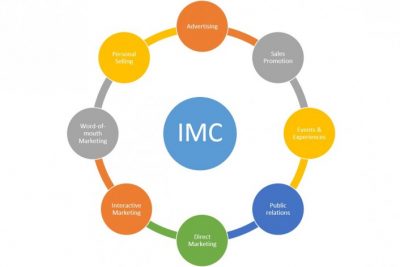Wikipedia defines Integrated Marketing Communication (IMC) as the application of consistent
brand messaging across both traditional and non-traditional
marketing channels and using different
promotional to reinforce each other. IMC entails leveraging the maximum potential of each marketing channel individually such that the overall efficacy of the marketing becomes more than the sum of the individual strengths. The concept of Integrated Marketing Communication implicitly provides auxiliary benefits such as - a single/synchronized brand voice and experience; cost efficiencies, generated through creativity and production; and opportunities for added value and bonus.

As per Philip Kotler, the marketing communications mix consists of the following eight major modes of communication:-

- Advertising – It includes all forms of promotion of products and services using the print media, radio, television, billboards, hoardings, posters, social media, etc.
- Sales promotion – It includes offers and incentives that are aimed at driving the sales of either existing or new products or services. Sales promotion can happen through consumer promotions, trade promotions, and business and sales force promotions.
- Events and experiences – Organizations conduct events and programmes to engage consumers so that their brand recall and brand recognition increase, which, in turn, will drive sales for the company.
- Public relations and publicity – This includes a set of engagement activities both internally for employees and externally for customers and other stakeholders, which would position, preserve, and promote the company’s image in the market.
- Direct Marketing – It includes the use of phone calls, emails, mailers, flyers, pamphlets, etc. to directly interact with customers.
- Interactive Marketing – This basically refers to the use of social media to engage customers. Promotional campaigns on different social media platforms are run to motivate customers to purchase the product or service.
- Word-of-mouth Marketing – This is the most inexpensive but important form of marketing, where one happy customer refers the company’s product or service to another prospect or customer, without seeking any incentive himself. I is completely based on the trust that she/he has on the company’s offering.
- Personal Selling – This is also referred to as direct selling, where the company’s sales force physically goes to the customer and pitches the product or service being offered. Though this method brings in a definite element of transparency and honesty, it is quite expensive, especially if the target market is a large and diverse one.
Effective communications for marketing can be developed using the following seven steps:-
- The first step is the proper identification of the organization’s current customers and other prospects who would be interested in buying the particular product or service offering.
- The second step is clearly defining what purpose needs to be achieved using the communication. This is majorly internal to the company. There can be four possible objectives that are to be achieved using the communications strategy. They are as follows:-
- Category Need
- Brand Awareness
- Brand Attitude
- Brand Purchase Intention
- The third step is designing the outbound communication to ensure that it is coherent and complete in every manner. For that, the following questions must be adequately answered:-
- What to say?
- How to say it?
- Who should say it?
- The fourth step is deciding how to convey the information that is to be communicated. The following choices are generally considered by companies:-
- Direct and personalized channels
- Generalized and mass channels
- Hybrid channels – which is a combination of the above
- The fifth step is to ensure that the entire communication campaign falls in line with the allocated budget. If this does not happen, then the company’s profitability can get seriously compromised.
- The sixth step is to allocate the overall budget among the different modes of communication which were described earlier. Key is getting the optimum balance in the communication mix.
- The final step comes into play once the campaign is live and underway. It involves taking feedback and conducting surveys to gauge the effectiveness of the communication and whether it reached the targeted audience. Depending on the response, the communication campaign can be adjudged as a success or a failure.
In the world of marketing, there exists a term called ‘Share of Voice’. Literally it means how much each company or brand is ‘shouting’ about its offering. In today’s super-competitive market, this occupies a position of prime importance – and if companies are to survive profitably, then both time and money investments in Integrated Marketing Communication is absolutely mandatory.
References:
http://en.wikipedia.org/wiki/Integrated_marketing_communications
‘Marketing Management – a South Asian perspective’ (14th Edition) by Philip Kotler, Kevin Lane Keller, Abraham Koshy, Mithileshwar Jha



